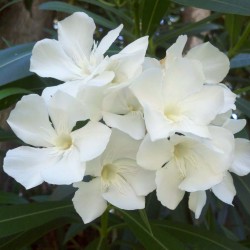Menu
-
Menuالعدمة
- Home
-
التصنيفات
-
-
التصنيفات
-
بذور الخضروات
-
أصناف حسب البلد
- أصناف من أرمينيا
- أصناف من البوسنة والهرسك
- أصناف من كرواتيا
- أصناف من فرنسا
- أصناف من ألمانيا
- أصناف من اليونان
- أصناف من المجر
- أصناف من الهند
- أصناف من إيطاليا
- أصناف من اليابان
- أصناف من شمال مقدونيا
- أصناف من بيرو
- أصناف من روسيا
- أصناف من صربيا
- أصناف من سلوفينيا
- أصناف من اسبانيا
- أصناف من تايلاند
- أصناف من تركيا
- أصناف من الولايات المتحدة الأمريكية
- بذور الطماطم
- بذور الذرة
- عائلة القرع
- الفول الأسرة
- بذور الخيار
- بذور الفلفل
- عائلة الجزرة
- عائلة البصل
- بذور الخس
- عائلة البطاطس
- عائلة الملفوف
- بذور الفجل
- عائلة الشمندر
- بذور البطيخ
- بذور بطيخ
- بذور القرنبيط
- عائلة عباد الشمس
-
أصناف حسب البلد
- بذور الفاكهة
- بذور الفلفل الحار
- بذور عشبة طبية
- تسلق بذور النباتات
- الأشجار - بذور بونساي
- بذور النخيل
- بذور الأعشاب الزينة
- بذور التبغ
-
بذور الخضروات
-
-
-
-
- منتجات جديدة
- التسليم - الدفع
- انشئ حساب
- FAQ
Last Product Reviews
Out of the two seeds, one germinated and the other one was dead and floatin...
By
 Riikka H on 07/03/2024
Riikka H on 07/03/2024
Verified Purchase
يوجد 170 منتجا.
عرض 151-165 من 170 منتجات

نبات مقاوم للبرد والصقيع

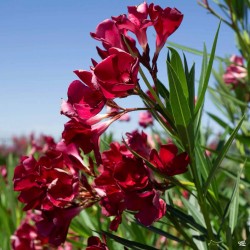
بذور الدفلى الحمراء
السعر
1.95 €
(SKU: T 62 R)
Seeds Gallery EU,
5/
5
<!DOCTYPE html>
<html>
<head>
<meta http-equiv="Content-Type" content="text/html; charset=UTF-8" />
</head>
<body>
<h2 dir="rtl"><strong>بذور الدفلى الحمراء</strong></h2>
<h2 dir="rtl"><span style="color: #ff0000;"><strong>ثمن حزمة من 10 بذور.</strong></span></h2>
<p dir="rtl">الدفلى أو الدفلى الزيتية (الاسم العلمي: Nerium oleander) هي نوع من النباتات تتبع جنس الدفلى من الفصيلة الدفلية. وهي نبات شديد السمية موطنه حوض البحر الأبيض المتوسط امتداداً إلى الصين.</p>
<p dir="rtl">شجيرة أو شجرة صغيرة معمرة يصل ارتفاعها إلى 2.5-6 متر، وهي ذات شكل قائم التفريع وأفرعها غزيرة ومقوسة.</p>
<p dir="rtl">الأوراق بسيطة ترتيبها سواري من 3 أوراق رمحية مطاولة ضيقة ذات قمة حادة تستدق عند القاعدة، كاملة الحواف، سميكة، سطحها العلوي أخضر داكن والسفلي أخضر باهت، مستديمة الخضرة.</p>
<p dir="rtl">الأزهار كبيرة ذات لون أبيض أو قرنفلي أو أحمر أو أرجواني، توجد في مجاميع متفرقة طرفية تظهر في المدة من نيسان/ابريل إلى تشرين الأول/أكتوبر. والثمرة جرابية متطاولة. وشديدة السمية.</p>
<p dir="rtl">منتشرة بكثرة وتناسب الزراعة في الشوارع والحدائق، وهي تصلح للزراعة في الأصص الكبيرة كما تزرع منفردة أو في مجموعات مع الشجيرات ذات الأوراق الكبيرة، وتصلح كسياج. تقلم تقليماً جائراً بعد ثالث عام. توجد في الأماكن المشمسة ونصف الظليلة، ولا تفضل الري الغزير، وتحتاج إلى تربة طينية خفيفة جيدة الصرف مسمدة بالأسمدة العضوية، تصاب بالحشرات القشرية والبق الدقيقي. وتتكاثر بالعقلة.</p>
</body>
</html>
T 62 R


نبات مقاوم للبرد والصقيع
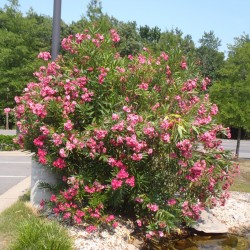
Rose Bay - Rose Laurel...
السعر
1.95 €
(SKU: T 62)
Seeds Gallery EU,
5/
5
<!DOCTYPE html>
<html>
<head>
<meta http-equiv="Content-Type" content="text/html; charset=UTF-8" />
</head>
<body>
<h2><span style="font-size: 14pt;"><strong>Rose Bay - Rose Laurel Seeds (Nerium oleander)</strong></span></h2>
<h2><span style="color: #ff0000; font-size: 14pt;"><strong>Price for Package of 10 seeds.</strong></span></h2>
<p>Undoubtedly a candidate for most poisonous plant in the garden but also a contender for most beautiful.</p>
<p>This species is considered to be native to Spain, the Balearic Islands and Morocco east through Mediterranean coastal countries to the Arabian Peninsula, Ethiopia, Niger, Afghanistan, Iran and Iraq to India and central China. It occurs as a non-native in parts of Africa, the Azores, Japan, Indonesia, Australia, New Zealand, the United States, central and eastern Mexico, Central and South America.</p>
<p>This species is very widely cultivated as an ornamental. All parts of the plant are poisonous and so it is not grazed or eaten. Steam from boiled leaves is inhaled to relieve sinusitis, pounded leaves are applied to the skin to relieve itching, ulcers and tumours (Jongbloed 2003); the leaves are used as an insecticide.</p>
<p>Nerium</p>
<p>Believed to come from the Greek ‘nerion’ which is, itself, believed to be based on ‘neros’, ‘wet’ or ‘fresh’.</p>
<p>oleander</p>
<p>Possibly a combination of the Latin ‘olea’, ‘olive’ and ‘rodandrum’, ‘rhododendron’ meaning the plant looks somewhat similar to a cross between these two.</p>
<p>Common Names and Synonyms</p>
<p>oleander, rose bay, common oleander, rose laurel</p>
<h2>WIKIPEDIA:</h2>
<p>Nerium oleander /ˈnɪəriəm ˈoʊliː.ændər/[3] is an evergreen shrub or small tree in the dogbane family Apocynaceae, toxic in all its parts. It is the only species currently classified in the genus Nerium. It is most commonly known as oleander, from its superficial resemblance to the unrelated olive Olea.[Note 1] It is so widely cultivated that no precise region of origin has been identified, though southwest Asia has been suggested. The ancient city of Volubilis in Morocco may have taken its name from the Berber name oualilt for the flower.[4] Oleander is one of the most poisonous commonly grown garden plants.</p>
<p><strong>Description</strong></p>
<p>Oleander grows to 2–6 m (6.6–19.7 ft) tall, with erect stems that splay outward as they mature; first-year stems have a glaucous bloom, while mature stems have a grayish bark. The leaves are in pairs or whorls of three, thick and leathery, dark-green, narrow lanceolate, 5–21 cm (2.0–8.3 in) long and 1–3.5 cm (0.39–1.38 in) broad, and with an entire margin. The flowers grow in clusters at the end of each branch; they are white, pink to red,[Note 2] 2.5–5 cm (0.98–1.97 in) diameter, with a deeply 5-lobed fringed corolla round the central corolla tube. They are often, but not always, sweet-scented.[Note 3] The fruit is a long narrow capsule 5–23 cm (2.0–9.1 in) long, which splits open at maturity to release numerous downy seeds.</p>
<p><strong>Habitat and range</strong></p>
<p>N. oleander is either native or naturalized to a broad area from Mauritania, Morocco, and Portugal eastward through the Mediterranean region and the Sahara (where it is only found sporadically), to the Arabian peninsula, southern Asia, and as far East as Yunnan in southern parts of China.[5][6][7][8] It typically occurs around dry stream beds. Nerium oleander is planted in many subtropical and tropical areas of the world. On the East Coast of the US, it grows as far north as Virginia Beach, Virginia, while in California and Texas it is naturalized as a median strip planting.[citation needed] Because of its durability, Oleander was planted prolifically on Galveston Island in Texas after the disastrous Hurricane of 1900. They are so prolific that Galveston is known as the 'Oleander City'; an annual Oleander festival is hosted every spring.[9] Oleander can be grown successfully outdoors in southern England, particularly in London and mild coastal regions of Dorset and Cornwall.</p>
<p><strong>Ecology</strong></p>
<p>Some invertebrates are known to be unaffected by oleander toxins, and feed on the plants. Caterpillars of the polka-dot wasp moth (Syntomeida epilais) feed specifically on oleanders and survive by eating only the pulp surrounding the leaf-veins, avoiding the fibers. Larvae of the common crow butterfly (Euploea core) also feed on oleanders, and they retain or modify toxins, making them unpalatable to would-be predators such as birds, but not to other invertebrates such as spiders and wasps.</p>
<p>The flowers require insect visits to set seed, and seem to be pollinated through a deception mechanism. The showy corolla acts as a potent advertisement to attract pollinators from a distance, but the flowers are nectarless and offer no reward to their visitors. They therefore receive very few visits, as typical of many rewardless flower species.[11][12] Fears of honey contamination with toxic oleander nectar are therefore unsubstantiated.</p>
<p><strong>Ornamental gardening</strong></p>
<p>Oleander is a vigorous grower in warm subtropical regions, where it is extensively used as an ornamental plant in parks, along roadsides, and as a windbreak. It will tolerate occasional light frost down to −10 °C (14 °F).,[8] though the leaves may be damaged. The toxicity of Oleander renders it deer-resistant. The plant is tolerant of poor soils, salt spray, and sustained drought, although it will flower and grow more vigorously with regular water. Nerium Oleander also responds well to heavy pruning, which should be done in the autumn or early spring to keep plants from becoming unruly.</p>
<p>In cold-winter climates Oleander can be grown in greenhouses and conservatories, or as potted indoor plants that can be kept outside in the summer. Oleander flowers are showy, profuse, and often fragrant, which makes them very attractive in many contexts. Over 400 cultivars have been named, with several additional flower colors not found in wild plants having been selected, including red, pink, yellow, and salmon; white and a variety of pinks are the most common. Double flowered cultivars like 'Mrs Isadore Dyer' or 'Mont Blanc' are enjoyed for their large, rose-like blooms and strong fragrance. Many dwarf cultivars have also been developed, which grow only to about 10' at maturity. In most Mediterranean climates they can be expected to bloom from April through October, with their heaviest bloom usually in May or June.</p>
<p><strong>Toxicity</strong></p>
<p>Oleander has historically been considered a poisonous plant because some of its compounds may exhibit toxicity, especially to animals, when consumed in large amounts. Among these compounds are oleandrin and oleandrigenin, known as cardiac glycosides, which are known to have a narrow therapeutic index and can be toxic when ingested.</p>
<p>Toxicity studies of animals administered oleander extract concluded that rodents and birds were observed to be relatively insensitive to oleander cardiac glycosides.[16] Other mammals, however, such as dogs and humans, are relatively sensitive to the effects of cardiac glycosides and the clinical manifestations of "glycoside intoxication".</p>
<p>However, despite the common "poisonous" designation of this plant, very few toxic events in humans have been reported. According to the Toxic Exposure Surveillance System, in 2002, 847 human exposures to oleander were reported to poison centers in the United States.[19] Despite this exposure level, from 1985 through 2005, only three deaths were reported. One cited death was apparently due to the ingestion of oleander leaves by a diabetic man.[20] His blood indicated a total blood concentration of cardiac glycosides of about 20 μg/l, which is well above the reported fatal level. Another study reported on the death of a woman who self-administered "an undefined oleander extract" both orally and rectally and her oleandrin tissue levels were 10 to 39 μg/g, which were in the high range of reported levels at autopsy.[21] And finally, one study reported the death of a woman who ingested oleander 'tea'.[22] Few other details were provided.</p>
<p>In contrast to consumption of these undefined oleander-derived materials, no toxicity or deaths were reported from topical administration or contact with N. oleander or specific products derived from them. In reviewing oleander toxicity, Lanford and Boor[23] concluded that, except for children who might be at greater risk, "the human mortality associated with oleander ingestion is generally very low, even in cases of moderate intentional consumption (suicide attempts)".</p>
<p>Toxicity studies conducted in dogs and rodents administered oleander extracts by intramuscular injection indicated that, on an equivalent weight basis, doses of an oleander extract with glycosides 10 times those likely to be administered therapeutically to humans are still safe and without any "severe toxicity observed".</p>
<p>In South Indian states such as Tamil Nadu and in Sri Lanka the seeds of related plant with similar local name (Kaneru(S) කණේරු) Cascabela thevetia produce a poisonous plum with big seeds. As these seeds contain cardenolides, swallowing them is one of the preferred methods for suicides in villages.</p>
<p><strong>Effects of poisoning</strong></p>
<p>Ingestion of this plant can affect the gastrointestinal system, the heart, and the central nervous system. The gastrointestinal effects can consist of nausea and vomiting, excess salivation, abdominal pain, diarrhea that may contain blood, and especially in horses, colic.[7] Cardiac reactions consist of irregular heart rate, sometimes characterized by a racing heart at first that then slows to below normal further along in the reaction. Extremities may become pale and cold due to poor or irregular circulation. The effect on the central nervous system may show itself in symptoms such as drowsiness, tremors or shaking of the muscles, seizures, collapse, and even coma that can lead to death.</p>
<p>Oleander sap can cause skin irritations, severe eye inflammation and irritation, and allergic reactions characterized by dermatitis.</p>
<p><strong>Treatment</strong></p>
<p>Poisoning and reactions to oleander plants are evident quickly, requiring immediate medical care in suspected or known poisonings of both humans and animals.[25] Induced vomiting and gastric lavage are protective measures to reduce absorption of the toxic compounds. Charcoal may also be administered to help absorb any remaining toxins.[7] Further medical attention may be required depending on the severity of the poisoning and symptoms. Temporary cardiac pacing will be required in many cases (usually for a few days) until the toxin is excreted.</p>
<p>Digoxin immune fab is the best way to cure an oleander poisoning if inducing vomiting has no or minimal success, although it is usually used only for life-threatening conditions due to side effects.</p>
<p>Drying of plant materials does not eliminate the toxins. It is also hazardous for animals such as sheep, horses, cattle, and other grazing animals, with as little as 100 g being enough to kill an adult horse.[26] Plant clippings are especially dangerous to horses, as they are sweet. In July 2009, several horses were poisoned in this manner from the leaves of the plant.[27] Symptoms of a poisoned horse include severe diarrhea and abnormal heartbeat. There is a wide range of toxins and secondary compounds within oleander, and care should be taken around this plant due to its toxic nature. Different names for oleander are used around the world in different locations, so, when encountering a plant with this appearance, regardless of the name used for it, one should exercise great care and caution to avoid ingestion of any part of the plant, including its sap and dried leaves or twigs. The dried or fresh branches should not be used for spearing food, for preparing a cooking fire, or as a food skewer. Many of the oleander relatives, such as the desert rose (Adenium obesum) found in East Africa, have similar leaves and flowers and are equally toxic.</p>
<p><strong>Folklore</strong></p>
<p>The alleged toxicity of the plant makes it the center of an urban legend documented on several continents and over more than a century. Often told as a true and local event, typically an entire family, or in other tellings a group of scouts, succumbs after consuming hot dogs or other food roasted over a campfire using oleander sticks.</p>
<p><strong>Garden history</strong></p>
<p>In his book Enquiries into Plants of circa 300 BC, Theophrastus described (among plants that affect the mind) a shrub he called onotheras, which modern editors render oleander; "the root of onotheras [oleander] administered in wine", he alleges, "makes the temper gentler and more cheerful".</p>
<p>The plant has a leaf like that of the almond, but smaller, and the flower is red like a rose. The plant itself (which loves hilly country) forms a large bush; the root is red and large, and, if this is dried, it gives off a fragrance like wine.</p>
<p>In another mention, of "wild bay" (Daphne agria), Theophrastus appears to intend the same shrub.</p>
<p>Oleander was a very popular ornamental shrub in Roman peristyle gardens; it is one of the flora most frequently depicted on murals in Pompeii and elsewhere in Italy. These murals include the famous garden scene from the House of Livia at Prima Porta outside Rome, and those from the House of the Wedding of Alexander and the Marine Venus in Pompeii.</p>
<p>Willa Cather, in her book The Song of the Lark, mentions oleander in this passage:</p>
<p>This morning Thea saw to her delight that the two oleander trees, one white and one red, had been brought up from their winter quarters in the cellar. There is hardly a German family in the most arid parts of Utah, New Mexico, Arizona, but has its oleander trees. However loutish the American-born sons of the family may be, there was never one who refused to give his muscle to the back-breaking task of getting those tubbed trees down into the cellar in the fall and up into the sunlight in the spring. They may strive to avert the day, but they grapple with the tub at last.</p>
<p>Oleander is the official flower of the city of Hiroshima, having been the first to bloom following the atomic bombing of the city in 1945.</p>
<p>It is the provincial flower of Sindh province.</p>
</body>
</html>
T 62 P

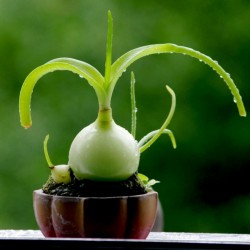
بذور بصل البحر (Albuca...
السعر
3.80 €
(SKU: CT 23)
Seeds Gallery EU,
5/
5
<meta http-equiv="Content-Type" content="text/html; charset=UTF-8" />
<h2 dir="rtl"><strong>بذور بصل البحر (Albuca bracteata) </strong></h2>
<h2 dir="rtl"><strong><span style="color: #ff0000;">ثمن عبوة من 3 بذور.</span> </strong></h2>
<p dir="rtl">يُعرف Albuca bracteata (syn. Ornithogalum longebracteatum) بالأسماء الشائعة البصل الحامل ، بصل البحر الكاذب ، وبصل البحر. إنه نوع من النباتات المزهرة منتفخة في عائلة Asparagaceae. يمكن أن يصل ارتفاع السيقان المزهرة إلى 90 سم ويمكن أن تحمل ما يصل إلى 100 زهرة بيضاء مخضرة.</p>
<p dir="rtl">أوراق لانسولات على شكل شريط ، طولها 60 سم (2 قدم) وعرضها 2.5 سم (1 بوصة) ، تبرز من لمبة كبيرة الحجم تقع بشكل كبير فوق الأرض. الجذور بيضاء ونضرة. توجد العديد من الأزهار البيضاء الصغيرة المعطرة التي يبلغ قطرها 0.5 سم ووسطها الأخضر على أعراق يمكن أن يصل ارتفاعها إلى 70-90 سم. عادة ما يحدث الإزهار من الربيع وحتى أوائل الشتاء (مايو إلى أغسطس في نصف الكرة الشمالي) ، مع 50 إلى 100 زهرة لكل ساق. يمكن أن يحتوي النبات الواحد على 300 زهرة في وقت واحد. يبلغ طول كبسولات الفاكهة 10 ملم وقطرها 6 ملم. البذور مستطيلة بأبعاد 4 × 1.5 مم. Albuca bracteata هو نبات كريبتوفيت ، حيث تموت أوراق الشجر مرة أخرى خلال فترات الجفاف.</p>
<p dir="rtl">غالبًا ما يُزرع كنبات للزينة. النبات قابل للتكيف للغاية وبالتالي فهو مثالي للنمو في الحاويات. يفضل أشعة الشمس المباشرة. يجب أن تكون الركيزة جيدة التصريف.</p>
<p dir="rtl">تحمل درجات حرارة تصل إلى -5 درجة مئوية.</p>
<p dir="rtl">في الطب ، تُستخدم أوراق النبات المطحونة لعلاج الجروح والكدمات. وفقًا لبعض المصادر ، فإن التأثير الطبي لهذا النبات يشبه تأثير الألوة فيرا.</p>
CT 23 (3 S)


نبات عملاق (به ثمار عملاقة)
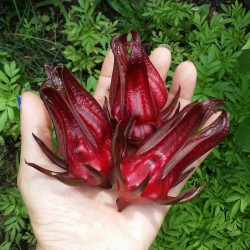
بذور الكركديه العملاقة...
السعر
3.50 €
(SKU: MHS 19 G)
Seeds Gallery EU,
5/
5
<div>
<h2 dir="rtl" class=""><strong>بذور الكركديه العملاقة (Hibiscus sabdariffa)</strong></h2>
<h2 dir="rtl"><span style="color: #ff0000;" class=""><strong>ثمن عبوة من 5 بذور.</strong></span></h2>
<p dir="rtl"><strong><span style="color: #000000; font-size: 18px;">ثمار هذا الكركديه أكبر بمرتين من أي كركديه أخرى.</span></strong><br>The roselle (Hibiscus sabdariffa) is a species of Hibiscus native to the Old World tropics, used for the production of bast fibre and as<br>an infusion. It is an annual or perennial herb or woody-based subshrub, growing to 2–2.5 m (7–8 ft) tall. The leaves are deeply three- to five-lobed, 8–15 cm (3–6 in) long, arranged alternately on the stems.</p>
</div>
<p dir="rtl">The flowers are 8–10 cm (3–4 in) in diameter, white to pale yellow with a dark red spot at the base of each petal, and have a stout fleshy calyx at the base, 1–2 cm (0.39–0.79 in) wide, enlarging to 3–3.5 cm (1.2–1.4 in), fleshy and bright red as the fruit matures. It takes about six months to mature.</p>
<p dir="rtl"><span><strong>Names</strong></span></p>
<p dir="rtl"><span>The roselle is known as the rosella or rosella fruit in Australia. It is also known as 'Belchanda' among Nepalese, Tengamora among Assamese and "mwitha" among Bodo tribals in Assam, চুকর Chukor in Bengali, Gongura in Telugu, Pundi in Kannada, Ambadi in Marathi, LalChatni or Kutrum in Mithila] Mathipuli in Kerala, chin baung in Burma, กระเจี๊ยบแดง KraJiabDaeng in Thailand, ສົ້ມ ພໍດີ som phor dee in Lao PDR, bissap in Senegal, Guinea Bissau, Mali, Burkina Faso, Ghana, Benin and Niger, the Congo and France, dah or dah bleni in other parts of Mali, wonjo in the Gambia, zobo in western Nigeria (the Yorubas in Nigeria call the white variety Isapa (pronounced Ishapa)), Zoborodo in Northern Nigeria, Chaye-Torosh in Iran, karkade (كركديه; Arabic pronunciation: [ˈkarkade])[dubious – discuss] in Egypt, Saudi Arabia, and Sudan, omutete in Namibia, sorrel in the Caribbean and in Latin America, Flor de Jamaica in Mexico, Saril in Panama, grosella in Paraguay and vinagreira, caruru-azedo or quiabo-roxo in Brazil. Rosela in Indonesia, asam belanda[1] in Malaysia. In Chinese it is 洛神花 (Luo Shen Hua) . In Zambia the plant is called lumanda in ciBemba, katolo in kiKaonde, or wusi in chiLunda.</span></p>
<p dir="rtl"><span><strong>Uses</strong></span></p>
<p dir="rtl"><span>The plant is considered to have antihypertensive properties. In some places, the plant is primarily cultivated for the production of bast fibre from the stem of the plant. The fibre may be used as a substitute for jute in making burlap.[2] Hibiscus, specifically Roselle, has been used in folk medicine as a diuretic, mild laxative, and treatment for cardiac and nerve diseases and cancer.[3]</span></p>
<p dir="rtl"><span>The red calyces of the plant are increasingly exported to America and Europe, where they are used as food colourings. Germany is the main importer. It can also be found in markets (as flowers or syrup) in some places such as France, where there are Senegalese immigrant communities. The green leaves are used like a spicy version of spinach. They give flavour to the Senegalese fish and rice dish thiéboudieune. Proper records are not kept, but the Senegalese government estimates national production and consumption at 700 t (770 short tons) per year. Also in Burma their green leaves are the main ingredient in making chin baung kyaw curry.</span></p>
<p dir="rtl"><span>In East Africa, the calyx infusion, called "Sudan tea", is taken to relieve coughs. Roselle juice, with salt, pepper, asafoetida and molasses, is taken as a remedy for biliousness.</span></p>
<p dir="rtl"><span>The heated leaves are applied to cracks in the feet and on boils and ulcers to speed maturation. A lotion made from leaves is used on sores and wounds. The seeds are said to be diuretic and tonic in action and the brownish-yellow seed oil is claimed to heal sores on camels. In India, a decoction of the seeds is given to relieve dysuria, strangury and mild cases of dyspepsia. Brazilians attribute stomachic, emollient and resolutive properties to the bitter roots.[4]</span></p>
<p dir="rtl"><span><strong>Leafy vegetable/Greens</strong></span></p>
<p dir="rtl"><span>In Andhra cuisine, Hibiscus cannabinus, called Gongura, is extensively used. The leaves are steamed along with lentils and cooked with Dal. The other unique dish prepared is gongura pachadi, it is prepared by mixing fried leaves with spices and made into a Gongura Pacchadi, the most famous dish of Andhra cuisine and is often described as king of all foods of Andhra ethnics(andhrulu)</span></p>
<p dir="rtl"><span>In Burmese cuisine, called chin baung ywet (lit. sour leaf), the roselle is widely used and considered an affordable vegetable for the population. It is perhaps the most widely eaten and popular vegetable in Burma.[5] The leaves are fried with garlic, dried or fresh prawns and green chili or cooked with fish. A light soup made from roselle leaves and dried prawn stock is also a popular dish.</span></p>
<p dir="rtl"><span><strong>Beverage</strong></span></p>
<p dir="rtl"><span>Cuisine: Among the Bodo tribals of Bodoland, Assam (India) the leaves of both hibiscus sabdariffa and hibiscus cannabinus are cooked along with chicken, fish or pork, one of their traditional cuisines</span></p>
<p dir="rtl"><span>In the Caribbean sorrel drink is made from sepals of the roselle. In Malaysia, roselle calyces are harvested fresh to produce pro-health drink due to high contents of vitamin C and anthocyanins. In Mexico, 'agua de Flor de Jamaica' (water flavored with roselle) frequently called "agua de Jamaica" is most often homemade. Also, since many untrained consumers mistake the calyces of the plant to be dried flowers, it is widely, but erroneously, believed that the drink is made from the flowers of the non-existent "Jamaica plant". It is prepared by boiling dried sepals and calyces of the Sorrel/Flower of Jamaica plant in water for 8 to 10 minutes (or until the water turns red), then adding sugar. It is often served chilled. This is also done in Saint Kitts and Nevis, Guyana, Antigua, Barbados, St. Lucia, Dominica, Grenada, Jamaica and Trinidad and Tobago where it is called 'sorrel'. The drink is one of several inexpensive beverages (aguas frescas) commonly consumed in Mexico and Central America, and they are typically made from fresh fruits, juices or extracts. A similar thing is done in Jamaica but additional flavor is added by brewing the tea with ginger and adding rum. It is a popular drink of the country at Christmas time. It is also very popular in Trinidad & Tobago but cinnamon, cloves and bay leaves are preferred to ginger. In Mali, Senegal, The Gambia, Burkina Faso and Benin calyces are used to prepare cold, sweet drinks popular in social events, often mixed with mint leaves, dissolved menthol candy, and/or various fruit flavors. The Middle Eastern and Sudanese drink "Karkade"(كركديه) is a cold drink made by soaking the dried Karkade flowers in cold water over night in a refrigerator with sugar and some lemon or lime juice added.It is then consumed with or without ice cubes after the flowers have been strained.In Lebanon, sometimes toasted pine nuts are tossed into the drink.</span></p>
<p dir="rtl"><span>With the advent in the U.S. of interest in south-of-the-border cuisine, the calyces are sold in bags usually labeled "Flor de Jamaica" and have long been available in health food stores in the U.S. for making a tea that is high in vitamin C. This drink is particularly good for people who have a tendency, temporary or otherwise, toward water retention: it is a mild diuretic.</span></p>
<p dir="rtl"><span>In addition to being a popular homemade drink, Jarritos, a popular brand of Mexican soft drinks, makes a Flor de Jamaica flavored carbonated beverage. Imported Jarritos can be readily found in the U.S.</span></p>
<p dir="rtl"><span>In the UK the dried calyces and ready-made sorrel syrup are widely and cheaply available in Caribbean and Asian grocers. The fresh calyces are imported mainly during December and January in order to make Christmas and New Year infusions, which are often made into cocktails with additional rum. They are very perishable, rapidly developing fungal rot, and need to be used soon after purchase – unlike the dried product, which has a long shelf-life.</span></p>
<p dir="rtl"><span>In Africa, especially the Sahel, roselle is commonly used to make a sugary herbal tea that is commonly sold on the street. The dried flowers can be found in every market. Roselle tea is also quite common in Italy where it spread during the first decades of the 20th century as a typical product of the Italian colonies. The Carib Brewery Trinidad Limited, a Trinidad and Tobago brewery, produces a Shandy Sorrel in which the tea is combined with beer.</span></p>
<p dir="rtl"><span>In Thailand, Roselle is generally drunk as a cool drink,[6] but also as a tea, believed to also reduce cholesterol. It can also be made into a wine.</span></p>
<p dir="rtl"><span>Hibiscus flowers are commonly found in commercial herbal teas, especially teas advertised as berry-flavoured, as they give a bright red colouring to the drink.</span></p>
<p dir="rtl"><span>Rosella flowers are sold as Wild Hibiscus flowers in syrup in Australia as a gourmet product. Recipes include filling them with goats cheese, serving them on baguette slices baked with brie, & placing one plus a little syrup, in a champagne flute before adding the champagne when the bubbles cause the flower to open.</span></p>
<p dir="rtl"><span><strong>Jam and preserves</strong></span></p>
<p dir="rtl"><span>In Nigeria, rosella jam has been made since Colonial times and is still sold regularly at community fetes and charity stalls. It is similar in flavour to plum jam, although more acidic. It differs from other jams in that the pectin is obtained from boiling the interior buds of the rosella flowers. It is thus possible to make rosella jam with nothing but rosella buds and sugar. Roselle is also used in Nigeria to make a refreshing drink known as Zobo.</span></p>
<p dir="rtl"><span>In Burma, the buds of the roselle are made into 'preserved fruits' or jams. Depending on the method and the preference, the seeds are either removed or included. The jams, made from roselle buds and sugar, are red and tangy.</span></p>
<p dir="rtl"><span>"Sorrel jelly" is manufactured in Trinidad.</span></p>
<p dir="rtl"><span>Rosella Jam is also made in Queensland, Australia as a home-made or speciality product sold at fetes and other community events.[7]</span></p>
<p dir="rtl"><span><strong>Medicinal uses</strong></span></p>
<p dir="rtl"><span>Many parts of the plant are also claimed to have various medicinal values. They have been used for such purposes ranging from Mexico through Africa and India to Thailand. Roselle is associated with traditional medicine and is reported to be used as treatment for several diseases such as hypertension and urinary tract infections.[8]</span></p>
<p dir="rtl"><span>Although Roselle has well documented hypotensive effects,[9] there is currently insufficient evidence to support the benefit of Roselle for either controlling or lowering blood pressure due to a lack of well designed studies that measure the efficacy of Roselle on patients with hypertension.[10]</span></p>
<p dir="rtl"><span>A double blind, placebo controlled, randomized trial was conducted to determine the effect of Roselle leaf extract on a group of 60 subjects with serum LDL values in the range of 130-190 ml/dl (<130 ml/dl is a goal value for most patients[11]) and no history of coronary heart disease. The experimental group received 1g of Roselle leaf extract while the placebo group received a similar amount of maltodextrin in addition to dietary and physical activity advice. Both groups had decreases in body weight, LDL cholesterol, and triglycerides that can likely be attributed to the dietary and physical activity advice. At a dose of 1g/day, Roselle leaf extract did not appear to have a blood lipid lowering effect.[12]</span></p>
<p dir="rtl"><span>Hibiscus sabdariffa has shown in vitro antimicrobial activity against E. coli.[13] A recent review stated that specific extracts of H. sabdariffa exhibit activities against atherosclerosis, liver disease, cancer, diabetes and other metabolic syndromes.</span></p>
<p dir="rtl"><span><strong>Phytochemicals</strong></span></p>
<p dir="rtl"><span>The plants are rich in anthocyanins, as well as protocatechuic acid. The dried calyces contain the flavonoids gossypetin, hibiscetine and sabdaretine. The major pigment, formerly reported as hibiscin, has been identified as daphniphylline. Small amounts of myrtillin (delphinidin 3-monoglucoside), Chrysanthenin (cyanidin 3-monoglucoside), and delphinidin are also present. Roselle seeds are a good source of lipid-soluble antioxidants, particularly gamma-tocopherol.[15]</span></p>
<p dir="rtl"> </p>
<p dir="rtl"><span><strong>Production</strong></span></p>
<p dir="rtl"><span>China and Thailand are the largest producers and control much of the world supply. Thailand invested heavily in roselle production and their product is of superior quality, whereas China's product, with less stringent quality control practices, is less reliable and reputable. The world's best roselle comes from the Sudan, but the quantity is low and poor processing hampers quality. Mexico, Egypt, Senegal, Tanzania, Mali and Jamaica are also important suppliers but production is mostly used domestically.[16]</span></p>
<p dir="rtl"><span>In the Indian subcontinent (especially in the Ganges Delta region), roselle is cultivated for vegetable fibres. Roselle is called meśta (or meshta, the ś indicating an sh sound) in the region. Most of its fibres are locally consumed. However, the fibre (as well as cuttings or butts) from the roselle plant has great demand in various natural fibre using industries.</span></p>
<p dir="rtl"><span>Roselle is a relatively new crop to create an industry in Malaysia. It was introduced in early 1990s and its commercial planting was first promoted in 1993 by the Department of Agriculture in Terengganu. The planted acreage was 12.8 ha (30 acres) in 1993, but had steadily increased to peak at 506 ha (1,000 acres) in 2000. The planted area is now less than 150 ha (400 acres) annually, planted with two main varieties.[citation needed] Terengganu state used to be the first and the largest producer, but now the production has spread more to other states. Despite the dwindling hectarage over the past decade or so, roselle is becoming increasingly known to the general population as an important pro-health drink in the country. To a small extent, the calyces are also processed into sweet pickle, jelly and jam. jimmon rubillos</span></p>
<p dir="rtl"><span><strong>Crop research</strong></span></p>
<p dir="rtl"><span>In the initial years, limited research work were conducted by University Malaya (UM) and Malaysian Agricultural Research and Development Institute (MARDI). Research work at Universiti Kebangsaan Malaysia (UKM) was initiated in 1999. In many respect, the amount of research work is still considered meagre in supporting a growing roselle industry in Malaysia.</span></p>
<p dir="rtl"><span>Crop genetic resources & improvement[edit]</span></p>
<p dir="rtl"><span>Genetic variation is important for plant breeders to increase the crop productivity. Being an introduced species in Malaysia, there is a very limited number of germplasm accessions available for breeding. At present, UKM maintains a working germplasm collection, and also conducts agronomic research and crop improvement.</span></p>
<p dir="rtl"><span>Mutation breeding[edit]</span></p>
<p dir="rtl"><span>Genetic variation is important for plant breeders to increase its productivity. Being an introduced crop species in Malaysia, there is a limited number of germplasm accessions available for breeding. Furthermore, conventional hybridization is difficult to carry out in roselle due to its cleistogamous nature of reproduction. Because of this, a mutation breeding programme was initiated to generate new genetic variability.[17] The use of induced mutations for its improvement was initiated in 1999 in cooperation with MINT (now called Malaysian Nuclear Agency), and has produced some promising breeding lines. Roselle is a tetraploid species; thus, segregating populations require longer time to achieve fixation as compared to diploid species. In April 2009, UKM launched three new varieties named UKMR-1, UKMR-2 and UKMR-3, respectively. These three new varieties were developed using variety Arab as the parent variety in a mutation breeding programme which started in 2006.</span></p>
<p dir="rtl"><span><strong>Natural outcrossing under local conditions</strong></span></p>
<p dir="rtl"><span>A study was conducted to estimate the amount of outcrossing under local conditions in Malaysia. It was found that outcrossing occurred at a very low rate of about 0.02%. However, this rate is much lower in comparison to estimates of natural cross-pollination of between 0.20% and 0.68% as reported in Jamaica.</span></p>
<p dir="rtl"><span><strong>Source: Wikipedia</strong></span></p>
MHS 19 G (5 S)


نبات مقاوم للبرد والصقيع
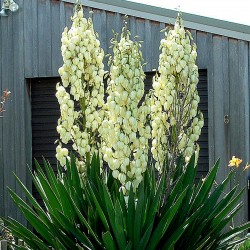
(Yucca filamentosa) يكة...
السعر
2.35 €
(SKU: CT 8)
Seeds Gallery EU,
5/
5
<h2 dir="rtl" class=""><strong>(Yucca filamentosa) يكة خيطية بذور</strong></h2>
<h2><span style="color: #ff0000;"><strong>ثمن عبوة من 5 بذور.</strong></span></h2>
عادة ما تكون بلا جذع ، فهي متعددة الملاقط برؤوس بطول 75 سم (30 بوصة) ، خيطية ، خضراء مزرقة ، أوراق ضيقة. يتم تمييز Y. filamentosa بسهولة عن أنواع اليوكا الأخرى بواسطة خيوط بيضاء سريعة على طول هوامش الأوراق. ينبع الزهرة حتى ارتفاع 3 أمتار (10 أقدام) من أزهار الكريمة المتدلية في أوائل الصيف. يتم تلقيحها بواسطة عثة اليوكا Tegeticula yuccasella. أنواع العث الأخرى ، مثل Tegeticula intermedia ، تستخدم هذا اليوكا أيضًا كنبات مضيف لوضع بيضها.<br /><br />الاستخدامات<br /><br />بمجرد إزالة البذور ، يمكن طهي الثمار وتناولها. يمكن أيضًا تناول بتلات الزهور الكبيرة في السلطات.<br /><br />يمكن استخدام أوراق وسيقان وجذور هذا النبات لصعق الأسماك. استخدمها الشيروكي لهذا الغرض.
CT 8 (5 S)


لا يمكن دفع هذا المنتج باستخدام PayPal أو البطاقة

Shirley Poppy Seeds Mixed...
السعر
1.95 €
(SKU: MHS 43)
Seeds Gallery EU,
5/
5
<div id="idTab1" class="rte">
<h2><strong>Shirley Poppy Seeds Mixed Colors, Decorative, Ornamental</strong></h2>
<h2><span style="color: #ff0202;"><strong>Price for a Package of 200 seeds.</strong></span></h2>
<p>Shirley Poppy (Papaver Rhoeas) - The Shirley Poppy comes from Shirley, England, where in the 1880s, a local vicar carefully selected and hybridized Poppies in his own wild flower garden. Over many years he obtained a strain of Poppies ranging in colors from white to pale lilac to pink and red, and unlike the wild Poppies these had no dark blotches at the base of the petals. Over the years, further wildflower Poppy selection has created the semi-double and double forms, as well as flowers with a ring of contrasting color around the edge called the picotee form. Easily grown from Shirley Poppy seeds, gardeners enthusiastically grow this variety for the wonderful display of diverse color and forms. How to Grow Poppies: Directly sow Poppy seeds in early spring before frosts have finished. Shirley Poppies grow best in loose soil that drains well. Press the flower seeds firmly into the soil and keep the soil moist until germination.<br /><br />Flower Specifications<br /><br /> Season: Annual<br /> USDA Zones: 3 - 9<br /> Height: 12 - 15 inches<br /> Bloom Season: Summer<br /> Bloom Color: Mix<br /> Environment: Full sun<br /> Soil Type: Loose, well-drained, pH 6.1 - 7.3<br /> Deer Resistant: Yes<br /><br />Planting Directions<br /><br /> Temperature: 55 - 60F<br /> Average Germ Time: 21 - 28 days<br /> Light Required: Yes<br /> Depth: Do not cover the seed but press into the soil<br /> Moisture: Keep seeds moist until germination<br /> Plant Spacing: 12 inches</p>
</div>
MHS 43 (200 S)

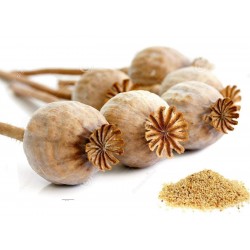
Common Garden White Poppy...
السعر
3.50 €
(SKU: MHS 140)
Seeds Gallery EU,
5/
5
<div id="idTab1" class="rte">
<h2 class=""><strong>Common Garden White Poppy Seeds (Papaver Somniferum)</strong></h2>
<h2><span style="color: #ff0000;">Price for Package of 2000 (1g), 10000 (5g) seeds.</span></h2>
<p><span style="font-size: 10pt;">Papaver somniferum, the Opium poppy, is the species of plant from which opium and poppy seeds are derived. Opium is the source of many narcotics, including morphine (and its derivative heroin), thebaine, codeine, papaverine, and noscapine. The Latin botanical name means the "sleep-bringing poppy", referring to the sedative properties of some of these opiates.</span></p>
<p><span style="font-size: 10pt;">The opium poppy is the only species of Papaveraceae that is an agricultural crop grown on a large scale. Other species, Papaver rhoeas and Papaver argemone, are important agricultural weeds, and may be mistaken for the crop.</span></p>
<p><span style="font-size: 10pt;">It is also valuable for ornamental purposes, and has been known as the "common garden poppy", referencing all the group of poppy plants.</span></p>
<p><span style="font-size: 10pt;">Poppy seeds of Papaver somniferum are an important food item and the source of poppyseed oil, a healthy edible oil that has many uses.</span></p>
<p><span style="font-size: 10pt;"><strong>Description</strong></span></p>
<p><span style="font-size: 10pt;">Papaver somniferum is an annual herb growing to 100cm. All parts of the plant are strongly glaucous, giving a greyish-green appearance, and the stem and leaves are sparsely covered with coarse hairs. The leaves are lobed and clasp the stem at the base. The flowers are up to 120mm diameter, normally with four white, mauve or red petals, sometimes with dark markings at the base. The fruit is a hairless, rounded capsule topped with 12–18 radiating stigmatic rays. All parts of the plant exude white latex when wounded.</span></p>
<p><span style="font-size: 10pt;"> </span></p>
<p><span style="font-size: 10pt;"><strong>History</strong></span></p>
<p><span style="font-size: 10pt;">Use of the opium poppy predates written history. Images of opium poppies have been found in ancient Sumerian artifacts (circa 4000 BC). The making and use of opium was known to the ancient Minoans.[7] Its sap was later named opion by the ancient Greeks, from whence it gained its modern name of opium.</span></p>
<p><span style="font-size: 10pt;">Opium was used for treating asthma, stomach illnesses, and bad eyesight.</span></p>
<p><span style="font-size: 10pt;">The First and Second Opium Wars among China, the British Empire and France took place in the late 1830s through the early 1860s, when the Chinese attempted to stop western traders smuggling opium into their country.</span></p>
<p><span style="font-size: 10pt;">Many modern writers, particularly in the 19th century, have written on the opium poppy and its effects, notably Thomas de Quincey in Confessions of an English Opium Eater</span></p>
<p><span style="font-size: 10pt;">The French Romantic composer Hector Berlioz used opium for inspiration, subsequently producing his Symphonie Fantastique. In this work, a young artist overdoses on opium and experiences a series of visions of his unrequited love.</span></p>
<p><span style="font-size: 10pt;">Opium poppies (flower and fruit) appear on the coat of arms of the Royal College of Anaesthetists.</span></p>
<p><span style="font-size: 10pt;"><strong><em>Legality</em></strong></span></p>
<p><span style="font-size: 10pt;"> Opium poppy cultivation in the United Kingdom does not require a license, but extracting opium for medicinal products does.</span></p>
<p><span style="font-size: 10pt;"> In Italy, it is forbidden to grow P. somniferum to extract the alkaloids, but small numbers of specimens can be grown without special permits for purely ornamental purposes.</span></p>
<p><span style="font-size: 10pt;"> Unlike in its neighbour countries Austria and Switzerland, where opium poppy is still cultivated legally, it has been delegalized in Western Germany after World War II, extending this regulation after German reunification in 1990 also to territories of former GDR, where opium poppy cultivation had remained legal until then.</span></p>
<p><span style="font-size: 10pt;"> In the United Arab Emirates, where the drug law is especially stern, at least one man was reported to have been imprisoned for possessing poppy seeds obtained from a bread roll.[9]</span></p>
<p><span style="font-size: 10pt;"> In New Zealand, section 9(4) of the Misuse of Drugs Act states, "It shall be a defence to a charge under subsection (1) [Cultivation of prohibited plants] if the person charged proves that the prohibited plant to which the charge relates was of the species Papaver somniferum, and that it was not intended to be a source of any controlled drug or that it was not being developed as a strain from which a controlled drug could be produced."</span></p>
<p><span style="font-size: 10pt;"> In northern Burma, opium bans have ended a century-old tradition of growing poppy. Between 20,000 and 30,000 ex-poppyfarmers left the Kokang region as a result of the ban in 2002.[11] People from the Wa region, where the ban was implemented in 2005, fled to areas where growing opium is still possible.</span></p>
<p><span style="font-size: 10pt;"> In the United States, opium is listed as a Schedule II controlled substance by the Drug Enforcement Administration. In addition, "Opium poppy and poppy straw" are also prohibited.[12] However, this is not typically enforced for poppies grown or sold for ornamental or food purposes.[4] Though the opium poppy is legal for culinary or æsthetic reasons, poppies were once grown as a cash crop by farmers in California; the law of poppy cultivation in the United States is somewhat ambiguous.</span></p>
<p><span style="font-size: 10pt;">The reason for the ambiguity is because The Opium Poppy Control Act of 1942 (now repealed),[14][15][16] stated that any opium poppy should be declared illegal, even if the farmers were issued a state permit. § 3 of The Opium Poppy Control Act stated:</span></p>
<p><span style="font-size: 10pt;"> It shall be unlawful for any person who is not the holder of a license authorizing him to produce the opium poppy, duly issued to him by the Secretary of the Treasury in accordance with the provisions of this Act, to produce the opium poppy, or to permit the production of the opium poppy in or upon any place owned, occupied, used, or controlled by him.</span></p>
<p><span style="font-size: 10pt;">This led to the Poppy Rebellion, and to the Narcotics Bureau arresting anyone planting opium poppies and forcing the destruction of poppy fields of anyone who defied the prohibition of poppy cultivation. Though the press of those days favored the Federal Bureau of Narcotics, the state of California supported the farmers who grew opium poppies for their seeds for uses in foods such as poppyseed muffins. Today, this area of law has remained vague and remains somewhat controversial in the United States. The Opium Poppy Control Act of 1942 was repealed on 27 October 1970.</span></p>
<p><span style="font-size: 10pt;"> The seeds themselves contain very small amounts of opiates,[4] and have no measurable narcotic effect in small quantities. See poppy tea. However, the television show MythBusters demonstrated that one could test positive for narcotics after consuming four poppy seed bagels. On the show Brainiac: Science Abuse, subjects tested positive after eating only two poppy seed bagels.</span></p>
<p><span style="font-size: 10pt;"><strong>Medicine</strong></span></p>
<p><span style="font-size: 10pt;">Australia (Tasmania), Turkey and India are the major producers of poppy for medicinal purposes and poppy-based drugs, such as morphine or codeine.[23] The USA has a policy of sourcing 80% of its narcotic raw materials from the traditional producers, India and Turkey.</span></p>
<p><span style="font-size: 10pt;">A recent initiative to extend opium production for medicinal purposes called Poppy for Medicine was launched by The Senlis Council which proposes that Afghanistan could produce medicinal opium under a scheme similar to that operating in Turkey and India.[25] The Council proposes licensing poppy production in Afghanistan, within an integrated control system supported by the Afghan government and its international allies, to promote economic growth in the country, create vital drugs and combat poverty and the diversion of illegal opium to drug traffickers and terrorist elements. Interestingly, Senlis is on record advocating reintroduction of poppy into areas of Afghanistan, specifically Kunduz, which has been poppy free for some time.</span></p>
<p><span style="font-size: 10pt;">The Senlis proposal is based in part on the assertion that there is an acute global shortage of opium poppy-based medicines some of which (morphine) are on the World Health Organisation's list of essential drugs as they are the most effective way of relieving severe pain. This assertion is contradicted by the International Narcotics Control Board (INCB), the "independent and quasi-judicial control organ monitoring the implementation of the United Nations drug control conventions". INCB reports that the supply of opiates is greatly in excess of demand.</span></p>
<p><span style="font-size: 10pt;">In March 2010, researchers from the Department of Biological Sciences at the University of Calgary published an article in Nature Chemical Biology about their discovery of two enzymes and their encoding genes, thebaine 6-O-demethylase (T6ODM) and codeine O-demethylase (CODM), involved in morphine biosynthesis derived from the opium poppy.[27] The enzymes were identified as non-heme dioxygenases, and were isolated using functional genomics.[27] Codeine O-demethylase produces the enzyme that converts codeine into morphine.</span></p>
<p><span style="font-size: 10pt;"><strong>Medical cultivation in the UK</strong></span></p>
<p><span style="font-size: 10pt;">In late 2006, the British government permitted the pharmaceutical company Macfarlan Smith (a Johnson Matthey company, FTSE 100) to cultivate opium poppies in England for medicinal reasons[29] after Macfarlan Smith's primary source, India, decided to increase the price of export opium latex. This move is well received by British farmers,[citation needed] with a major opium poppy field based in Didcot, England. As of 2012, they were growing in Dorset, Hampshire, Oxfordshire and Lincolnshire as a spring-sown breakcrop recognised under the single payment scheme farm subsidy.[30] The Office of Fair Trading has alerted the government to their monopoly position on growing in the UK and worldwide production of diamorphine and recommended consideration.[29] The governments response advocated the status quo, being concerned interference might cause the company to stop production.</span></p>
<p><span style="font-size: 10pt;"><strong>Use as food</strong></span></p>
<p><span style="font-size: 10pt;">The opium poppy is the source of two food ingredients: poppy seed and poppyseed oil. The seeds contain very low levels of opiates,[4] and the oil extracted from them contains even less. Both the oil and the seed residue also have commercial uses.</span></p>
<p><span style="font-size: 10pt;"><strong>Poppy seeds</strong></span></p>
<p><span style="font-size: 10pt;">Poppy seeds are commonly used in cuisine from many different cultures. They can be dry roasted and ground to be used in wet curry (curry paste) or dry curry. They have a creamy and nut-like flavor, and when used with ground coconut, the seeds provide a unique and flavour-rich curry base.</span></p>
<p><span style="font-size: 10pt;"><strong>Ornamental cultivation</strong></span></p>
<p><span style="font-size: 10pt;">Once known as the "common garden poppy", live plants and seeds of the opium poppy are widely sold by seed companies and nurseries in most of the western world, including the United States. Poppies are sought after by gardeners for the vivid coloration of the blooms, the hardiness and reliability of the poppy plants, the exotic chocolate-vegetal fragrance note of some cultivars, and the ease of growing the plants from purchased flats of seedlings or by direct sowing of the seed. Poppy seed pods are also sold for dried flower arrangements.</span></p>
<p><span style="font-size: 10pt;">Since "opium poppy and poppy straw" are listed in Schedule II of the United States' Controlled Substances Act, a DEA license may be required to grow poppies in ornamental or display gardens. In fact, the legal status of strictly ornamental poppy gardens is more nuanced, and destruction of ornamental poppy installations or prosecution of gardeners (except those caught extracting opium via capsule scarification or tea extraction) are virtually unheard of.[4] During the early spring, opium poppies can be seen flowering in gardens throughout North America and Europe, and beautiful displays are found in many private planters, as well as in public botanical and museum gardens (e.g., United States Botanical Garden, Missouri Botanical Garden, North Carolina Botanical Garden).</span></p>
<p><span style="font-size: 10pt;">Many countries grow the plants, and some rely heavily on the commercial production of the drug as a major source of income. As an additional source of profit, the seeds of the same plants are sold for use in foods, so the cultivation of the plant is a significant source of income. This international trade in seeds of P. somniferum was addressed by a UN resolution "to fight the international trade in illicit opium poppy seeds" on 28 July 1998.</span></p>
<p><span style="font-size: 10pt;"><strong>Popular culture</strong></span></p>
<p><span style="font-size: 10pt;">In the 19th century Thomas de Quincey wrote Confessions of an English Opium-Eater (1821). A book on Opium and allegedly the first book in the series of drug-addiction literature.</span></p>
<p><span style="font-size: 10pt;">Recently, a feature film entitled The Opium Eater was released exploring the life of Eric Detzer and how he would go about acquiring opium poppies from flower shops and gardens in the Pacific Northwest (north of Seattle) to feed his addiction. This true story is based on an autobiography, Poppies: Odyssey of an Opium Eater written by Detzer, and starring David Bertelsen. Since the festival release of this film in Breckenridge, CO, eBay has stopped allowing the sale of opium poppy pods on their auction site. This may also be attributed to the death of a Colorado teen, who overdosed on opium tea around the same time.</span></p>
<p><span style="font-size: 10pt;">What may be the most well known literary use of the poppy occurs both in L. Frank Baum's The Wonderful Wizard of Oz and in MGM's classic 1939 film based on the novel.</span></p>
<p><span style="font-size: 10pt;">In the novel, while on their way to the Emerald City, Dorothy, the Scarecrow, the Tin Man, and the Cowardly Lion walk through a field of poppies, and both Dorothy and the Lion mysteriously fall asleep. The Scarecrow and the Tin Man, not being made of flesh and blood, are unaffected. They carry Dorothy to safety and place her on the ground beyond the poppy field. While they are considering how to help the Lion, a field mouse runs in front of them, fleeing a cougar. The Tin Man beheads the cougar with his axe, and the field mouse pledges her eternal gratitude. Being the Queen of the Field Mice, she gathers all her subjects together. The Tin Man cuts down several trees, and builds a wagon. The Lion is pushed onto it, and the mice pull the wagon safely out of the poppy field.</span></p>
<p><span style="font-size: 10pt;">In the 1939 film, the sequence is considerably altered. The poppy field is conjured up by the Wicked Witch of the West, and it appears directly in front of the Emerald City, preventing the four travelers from reaching it. As in the novel, Dorothy and the Cowardly Lion fall asleep, but in a direct reversal of the book, the Scarecrow and the Tin Man are unable to carry Dorothy. Glinda, who has been watching over them, conjures up a snowfall which kills the poppies' narcotic power and enables Dorothy and the Lion to awaken. Unfortunately, the Tin Man has been weeping in despair, and the combination of his tears and the wet snow has caused him to rust. After he is oiled by Dorothy, the four skip happily toward the Emerald City.</span></p>
<p><span style="font-size: 10pt;">In Baum's other Oz books, Oz's ruler, Princess Ozma, is often shown wearing poppies in her hair as decoration.</span></p>
</div><script src="//cdn.public.n1ed.com/G3OMDFLT/widgets.js"></script>
MHS 140 (1g)

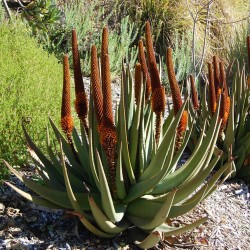
بذور صبار ذيل القط (الصبار...
السعر
4.00 €
(SKU: CT 27)
Seeds Gallery EU,
5/
5
<div id="idTab1" class="rte">
<h2 id="short_description_content" dir="rtl" class=""><strong>بذور صبار ذيل القط (Aloe castanea)</strong></h2>
<h2 dir="rtl"><span style="color: #ff0000;"><strong>ثمن عبوة من 5 بذور.</strong></span></h2>
<div>
<p dir="rtl">الصبار هو أحد أنواع الألوة المتوطنة في جنوب إفريقيا.<br>صبار رائع يتكون من شجيرة أو شجرة صغيرة يصل ارتفاعها إلى ما يقرب من 4 أمتار ولها أغصان قصيرة وسميكة تحتوي على وريدات من أوراق ضيقة أو خضراء أو زرقاء شاحبة. النورات متفرعة بشكل ضئيل وتبدو مثل ذيول القطط.<br><br>تنمو بسهولة من البذور في المناخات الدافئة المعتدلة والاستوائية في مناطق وزارة الزراعة الأمريكية من 9 إلى 11. </p>
</div>
</div>
CT 27 (5 S)

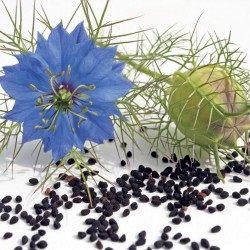
(Nigella sativa) حبة البركة...
السعر
2.15 €
(SKU: MHS 128)
Seeds Gallery EU,
5/
5
<h2><strong>(Nigella sativa) حبة البركة بذور</strong></h2>
<h2 dir="rtl" class=""><span style="color: #ff0000;" class=""><strong>ثمن عبوة تحتوي على 500 (1،5 جرام) بذرة.</strong></span></h2>
<p>الشونيز المزروع، حبة البركة، الحبة السوداء أو الكمون الأسود نوع نباتي ينتمي إلى جنس الشونيز من الفصيلة الحوذانية. تنتج ثماره البذور المعروفة بحبة البركة.</p>
<p>تعرف بأسماء أخرى منها: القزحة، الشونيز، شونياز، بالكالونجي الأسود، الكراوية السوداء.</p>
<p>الوصف النباتي<br>عشبة حولية تعلو 30 سم، لها ساق منتصبة متفرعة وأوراق دقيقة عميقة الفصوص وأزهار زرقاء إلى رمادية وقرون وبذور مسننة، موطنها الجزيرة العربية والمشرق العربي والمغرب العربي وإيران والهند وباكستان، تزرع في كثير من أنحاء آسيا ومنطقة حوض البحر الأبيض المتوسط.</p>
<p>الاستعمالات الطبية<br>تعتبر بذورها طاردة للأرياح ومنشطة ومدرة للبول. عجينة من البذور تشفي الجروح القاطعة ولدغات العقرب والأكزيما. والبذور مطهرة ومضادة للديدان المعوية ولاسيّما لدى الأطفال ومدرة للطمث ومفيدة في الربو ومقوية لجهاز المناعة. وتوضع البذور بين طيات الملابس المخزونة كطاردة للعثة. حبة البركة مفيدة في أمراض البروستاتا والقولون ومنشطة للأعصاب والجنس أو لعلاج السكري. والجزء المستخدم من هذا النبات هو بذورها السوداء حيث تجمع البذور عندما تنضج. تحتوي البذور على 40% من الزيت الثابت، واحد من الصابونينات (الميلانتين) وحوالي 1.4% من الزيت الطيّار.</p>
<p>يحتوي زيت حبة البركة على العديد من الحموض الدهنية الأساسيّة. تحتوي حبة البركة على مادة Nigellone وهي أحد مضادات الأكسدة الطبيعية وكذلك الجلوتاثيون. تحتوي بذور حبة البركة على حمض الأرغينين.</p>
<p>وقد عثر على الحبة السوداء في قبر توت عنخ آمون، وقد أورد دستورديرس الطبيب الاغريقي (طبيب يوناني شهير عاش في القرن الأول الميلادي)، أن بذور الحبة السوداء تؤخذ لعلاج الصداع والنزلة الانفية وألم الأسنان والديدان المعدية، كما تؤخذ بكميات كبيرة كمدر للبول وللحض على الحيض وزيادة درّ الحليب.</p>
<p>ورد في الحديث عن نبي الإسلام محمد أنه قال: إن هذه الحبة السوداء شفاء من كل داء إلا السام، قلت: وما السام؟ قال الموت ".</p>
<p>على غرار كثير من أعشاب التوابل الطهيّة، تفيد بذور الحلبة السوداء الجهاز الهضمي وتلطف ألم المعدة وتشنجاتها وتخفف الريح وانتفاخ البطن والمغص. كما أن البذور مطهرة.</p>
<p>وكانت حبة البركة تستعمل منذ القدم في تتبيل الفطائر لتكسبها الطعم الشهي، كما تخلط مع العسل الأسود والسمسم بعد سحقها حلاوة تؤخذ على الريق كمقوية ومنبهة وطاردة للبلغم ولمقاومة شدة البرد في الشتاء القارص وزيادة المناعة ضد نوبات البرد والربو.</p>
<p>وقال عنها ابن سينا صاحب القانون : " والشونيز (حبة البركة) حريف مقطع للبلغم جلاء ويحلل الريح والنفخ وتنقيته بالغة ويوضع مع الخل على البثور اللبنية ويحل الأورام البلغمية والصلبة ومع الخل على القروح البلغمية والجرب المتقرح، وينفع من الزكام وخصوصآ مسحوقآ ومجعولآ في صرة كتان، يطلى على جبهة من به صداع. وإذا نقع في الخل ليلة ثم سحق واعطي للمريض يستنشقه نفع من الأوجاع المزمنة في الرأس. لقتل الديدان ولو طلاء على السرة، ويدر الطمث إذا استعمل أيامآ ويسقى بالعسل والماء الحار للحصاة في المثانة والكلى ".</p>
<h2><span class="mw-headline" id="الخصائص_الطبية">الخصائص الطبية</span></h2>
<ul>
<li><b>الحبة السوداء والملاريا</b>: عرضت نتائج دراستان نشرتها المجلة الأمريكية للسموم والعاقير الطبية والمجلة الماليزية للعلوم الطبية لهذا العام 2007 نتائج دراستان قام بها باحث يمني من جامعة ذمار اليمنية الدكتور (عبد الإله حسين أحمد الأضرعي) والبرفيسور (زين العابدين بن أبو حسن) من الجامعة الوطنية الماليزية عن فعالية الحبة السوداء ضد طفيل الملاريا حيث أظهرت النتائج المخبرية التي أجريت على الفئران فعالية قوية للحبة السوداء في إخماد المرض وعلاجة والوقاية منه والذي يوعد بأنها تحتوي على مواد فعالة قد يتم استخلاصها لتمثل قفزة جديدة ضد مرض الملاريا(1,2).</li>
<li><b>الحبة السوداء والجراثيم</b>: قام الدكتور (مرسي) من جامعة القاهرة بإجراء دراسة نشرت في مجلة Acta Microbiol Pol عام 2000 للتعرف على تأثيرات الحبة السوداء على الجراثيم..فقام بدراسة 16 نوعًا من الجراثيم سلبية لصبغة غرام، و6 أنواع من الجراثيم الإيجابية لصبغة غرام. فقد أظهر استجابة بعض أنواع الجراثيم لخلاصة الحبة السوداء(3). الحبة السوداء.. والفطور: ومن باكستان، من جامعة آغاخان، ظهرت دراسة نشرت في شهر فبراير 2003 في مجلة Phytother Res فقد عولجت الفئران التي أحدثت عندها إصابة بفطور المبيضات البيض Candida Albicans بخلاصة الحبة السوداء. وتبين للباحثين حدوث تثبيط شديد لنمو فطور المبيضات البيض. ويقول الدكتور خان في ختام بحثه: إن نتائج هذه الدراسة تقول بفعالية زيت الحبة السوداء في علاج الفطور(4).</li>
<li><b>الحبة السوداء وقاية من تخرب الكبد</b>: من المعلوم أن زيت الحبة السوداء يملك تأثيرات وقائية للكبد تحميه من بعض أنواع التسممات الكبدية. ومن المعروف أيضًا أن الحبة السوداء نفسها تستخدم في الطب الشعبي في علاج أمراض الكبد. ولهذا قام الدكتور (الغامدي) من جامعة الملك فيصل في الدمام بإجراء دراسة على الفئران لمعرفة تأثير محلول مائي من الحبة السوداء في وقاية الكبد من مادة سامة تدعى رباعي كلور الكربون (Carbon tetrachloride). وقد نشرت هذه الدراسة في مجلة (Am J Clin Med) في شهر مايو 2003م. وتبين أن إعطاء محلول الحبة السوداء قد أدى إلى الإقلال من التأثيرات السمية لرابع كلور الكربون على الكبد. فقد كان مسـتوى إنزيمات الكبد أقل عند الفئران التي أعطيت الحبة السوداء، كما كان تأثير المادة السامة على أنسجة الكبد أقل وضوحًا(5). وفي دراسة أخرى نشرت في مجلة (Phytother Res) في شهر سبتمبر 2003 أكد الباحثون أن الفئران التي أعطيت زيت الحبة السوداء كانت أقل عرضة للإصابة بتخريب الكبد عند إعطائه المواد السامة مثل رابع كلور الكربون(6).</li>
<li><b>الحبة السوداء في الوقاية من سرطان الكبد</b>: وفي دراسة نشرت في عدد أكتوبر 2003 في مجلة (J Carcinog) قام الباحثون من جامعة (Kelaniya) في سريلانكا بإجراء دراسة على 60 فأرًا أحدث عندهم سرطان الكبد بواسطة مادة تدعى (diethylnitrosamine). وأعطي مجموعة من هذه الفئران مزيجًا من الحبة السوداء وأعشاب أخرى، وتابع الباحثون هذه الفئران لمدة عشرة أسابيع. وبعدها قاموا بفحص النسيج الكبدي عند الفئران، فوجدوا أن شدة التأثيرات السرطانية كانت أقل بكثير عند الفئران التي عولجت بهذا المزيج المذكور، والذي يشتمل على الحبة السوداء. واستنتج الباحثون أن هذه المواد يمكن أن تسهم في وقاية الكبد من التأثيرات المسرطنة(7).</li>
<li><b>الحبة السوداء وقاية من<span> </span>سرطان القولون</b>: هل يمكن للحبة السوداء أن تقي من سرطان القولون؟ سؤال طرحه باحثون من جامعة طنطا بمصر، ونشر بحثهم في مجلة Nutr Cancer في شهر فبراير 2003م. فقد أجرى الباحثون دراسة على 45 فأرًا، وأعطوا مادة كيميائية تسبب سرطان القولون. وأعطي ثلاثون فأرًا زيت الحبة السوداء عن طريق الفم. وبعد 14 أسبوعًا من بداية التجربة، لاحظ الباحثون عدم وجود أية تغيرات سرطانية في القولون أو الكبد أو الكلى عند الفئران التي أعطيت زيت الحبة السوداء، مما يوحي بأن زيت الحبة السوداء الطيار له القدرة على منع حدوث سرطان القولون(8).</li>
<li><b>الحبة السوداء وسرطان الثدي</b>: وفي دراسة خرجت من جامعة (جاكسون ميسيسيبي) في الولايات المتحدة ونشرت في مجلة Bio Med Sci Instrum عام 2003، وجد الباحثون أن استعمال خلاصة الحبة السوداء كانت فعالة في تثبيط خلايا سرطان الثدي، مما يفتح الأبواب إلى المزيد من الدراسات في هذا المجال(9).</li>
<li><b>الحبة السوداء ومرض السكر</b>: وفي دراسة حديثة نشرت في مجلة (tohoku J Exp Med) في شهر ديسمبر 2003م قام الباحثون من جامعة (يوزنكويل) في تركيا بإجراء دراسة على خمسين فأرًا أحدث عندهم مرض السكر وذلك بإعطائهم مادة تدعى (streptozotocin) داخل البريتوان في البطن. وقسمت الفئران بعدها إلى مجموعتين: الأولى أعطيت زيت الحبة السوداء الطيار داخل بريتوان البطن يوميٌّا ولمدة ثلاثين يومًا، في حين أعطيت المجموعة الثانية محلولاً ملحيٌّا خاليًا من زيت الحبة السوداء. ووجد الباحثون أن إعطاء زيت الحبة السوداء للفئران المصابة بمرض السكر قد أدى إلى خفض في سكر الدم عندها، وزيادة مستوى الأنسولين في الدم، كما أدى إلى تكاثر وتنشط في خلايا بيتا (في البنكرياس) والمسؤولة عن إفراز الأنسولين، مما يوحي بأن الحبة السوداء يمكن أن تساعد في علاج مرض السكر(10). وفي دراسة أخرى من اليابان نشرت في شهر ديسمبر 2002 في مجلة Res Vet Sci وجد الباحثون أن لزيت الحبة السوداء تأثيرًا منشطًا لإفراز الأنسولين عند الفئران التي أحدث عندها مرض السكر، وقد أدى استعمال زيت الحبة السوداء عند هذه الفئران إلى خفض سكر الدم عندها(11). أما الدكتور محمد الدخاخني فقد نشر بحثًا في مجلة Planta Med في عام 2002 واقترح فيه أن تأثير زيت الحبة السوداء الخافض لسكر الدم ربما لا يكون عن طريق زيادة أنسولين الدم، بل ربما يكون عن طريق تأثير خارج عن البنكرياس، ولكن الأمر بحاجة إلى مزيد من الدراسات العلمية(12). ومن جامعة (يوزنكو) في تركيا ظهرت دراسة نشرت في عام 2001 وأجريت هذه المرة على الأرانب النيوزيلندية، فقد قسمت الأرانب إلى مجموعتين، أحدث عندها مرض السكر، عولجت الأولى بإعطاء خلاصة الحبة السوداء عن طريق الفم يوميٌّا ولمدة شهرين بعد إحداث مرض السكر. وجد الباحثون حدوث انخفاض في سكر الدم عند التي عولجت بخلاصة الحبة السوداء، كما ازداد لديها العوامل المضادة للأكسدة، والتي يمكن أن تقلل من حدوث تصلب الشرايين(13).</li>
<li><b>الحبة السوداء والأمراض التحسسية</b>: وفي دراسة أخرى من جامعة (charite) في برلين (ألمانيا) قام الباحثون بإجراء دراسة على 152 مريضًا مصابًا بأمراض تحسسية (التهاب الأنف التحسسي، الربو القصبي، الأكزيما التحسسية) وقد نشرت الدراسة في مجلة (tohoku J Exp Med) في عدد ديسمبر 2003 وعولج هؤلاء المرضى بكبسولات تحتوي على زيت الحبة السوداء بجرعة تراوحت بين 40ـ80 ملغ/ كغ باليوم. وقد طلب من المرضى أن يسجلوا وفق معايير قياسية خاصة شدة الأعراض عندهم خلال التجربة. وأجريت معايرة عدة فحوص مخبرية مثل (IgE) تعداد الكريات البيض الحمضية، مستوى الكورتيزول، الكولسترول المفيد والكولسترول الضار. وقد أكدت نتائج الدراسة تحسن الأعراض عند كل المرضى المصابين بالربو القصبي أو التهاب الأنف التحسسي أو الأكزيما التحسسية، وقد انخفض مستوى الدهون الثلاثية (ترغليسريد) بشكل طفيف، في حين زاد مستوى الكولسترول المفيد بشكل واضح، ولم يحدث أي تأثير يذكر على مستوى الكورتيزول أو كريات البيض اللمفاوية. واستنتج الباحثون الألمان أن زيت الحبة السوداء فعال ـ كعلاج إضافي ـ في علاج الأمراض التحسسية(14).</li>
<li><b>الحبة السوداء والربو القصبي</b>: منذ سنين ومستحضرات الحبة السوداء تستخدم في علاج السعال والربو القصبي، فهل من دليل علمي حديث؟ لقد قام باحثون من جامعة الملك سعود بالرياض بدراسة تأثير<span> </span>الثيموكينون<span> </span>(وهو المركب الأساسي الموجود في زيت الحبة السوداء) على قطع من رغامى (Trachea) الخنزير الوحشي Guinea Pig. وأظهرت نتائج الدراسة أن الثيموكينون يرخي من عضلات الرغامى، أي أنه يوسع الرغامى والقصبات، وهذا ما يساعد في علاج الربو القصبي(15).</li>
<li><b>الحبة السوداء في علاج الإسهال والربو</b>: من المعروف أن الحبة السوداء تستخدم في علاج الإسهال والربو القصبي منذ مدة طويلة. وقد قام الدكتور (جيلاني) بدراسة تأثير خلاصة الحبة السوداء في المختبر لمعرفة فعلها الموسع للقصبات والمرخي للعضلات Spasmolytic. وأكدت الدراسة أن لزيت الحبة السوداء تأثيرًا مرخيًا للعضلات وموسعًا للقصبات، بآلية حصر الكالسيوم، مما يعطي قاعدة تفسر التأثير المعروف للحبة السوداء في الطب الشعبي(16).</li>
<li><b>الحبة السوداء والمعدة</b>: وللحبة السوداء دور وقائي لغشاء المعدة، فقد قام باحثون من جامعة القاهرة بإحداث أذيات في غشاء المعدة عند الفئران، ثم عولجت هذه الفئران بزيت الحبة السوداء أو بالثيموكينون (المادة الفعالة في الحبة السوداء)، وكان تأثيرهما واضحًا في وقاية غشاء المعدة من التأثيرات المخرشة والأذيات الضارة للمعدة(17). ومن جامعة الإسكندرية ظهر بحث قام به الخبير العالمي الكبير في مجال الحبة السوداء الدكتور محمد الدخاخني. حيث قام ببحث تأثير الحبة السوداء الواقي لغشاء المعدة من التخريشات التي يسببها الكحول عند الفئران. فتبين أن زيت الحبة السوداء قد مارس تأثيرًا واقيًا فعالاً ضد التأثير المخرش للمعدة الذي يحدثه الكحول(18).</li>
<li><b>الحبة السوداء واعتلال الكلية</b>: أجرى باحثون من جامعة الأزهر دراسة حول تأثير الثيموكينون على اعتلال الكلية، والذي أحدث عند الفئران بواسطة مادة تدعى Doxorubicin. فتبين أن الثيموكينون (المادة الفعالة في الحبة السوداء) قد أدى إلى تثبيط طرح البروتين والألبومين في البول، وأن له فعلاً مضادٌّا للأكسدة يثبط التأثيرات السلبية التي حدثت في الكلية. وهذا ما يوحي بأن الثيموكينون يمكن أن يكون له دور في الوقاية من الاعتلال الكلوي(19).</li>
<li><b>الحبة السوداء وقاية للقلب والشرايين</b>: من المعروف أن ارتفاع مادة تدعى (هوموسيستين) في الدم تزيد من فرص حدوث مرض شرايين القلب وشرايين الدماغ والأطراف. وقد وجد العلماء أن إعطاء الفيتامينات (حمض الفوليك، فيتامين ب6، فيتامين ب12) قد أدى إلى خفض مستوى الهوموسيستين في الدم. ومن هنا، قام باحثون في جامعة الملك سعود بالمملكة العربية السعودية بإجراء دراسة لمعرفة تأثير الحبة السوداء على مستوى هوموسيستين الدم. وقد نشرت الدراسة في مجلة Int J Cardiol في شهر يناير 2004م(20). وقد أعطى الباحثون مجموعة من الفئران مادة (ثيموكينون) (100 ملغ/ كغ)، وهي المادة الفعالة الأساسية في الحبة السوداء لمدة ثلاثين دقيقة، ولمدة أسبوع. ووجد الباحثون أن إعطاء مادة ثيموكينون قد أدى إلى حماية كبيرة ضد حدوث ارتفاع الهوموسيستين (عندما تعطى للفئران مادة ترفع مستوى الهوموسيستين). ومع ارتفاع الهوموسيستين يحدث ارتفاع واضح في مستوى الدهون الثلاثية والكولسترول وحالة من الأكسدة الضارة للجسم. وقد تبين للباحثين أن إعطاء خلاصة الحبة السوداء قد أدى إلى إحباط تلك التأثيرات الضارة التي ترافق ارتفاع الهوموسيستين. مما يعني أن زيت الحبــة السـوداء يمكن أن يقي القلب والشرايين من التأثيرات الضارة لارتفاع الهوموسيستين وما يرافقه من ارتفاع في دهـون الدم. ولا شك أن الأمر بحاجة إلى المزيد من الدراسات في هذا المجال.</li>
<li><b>الحبة السوداء مضاد للأكسدة</b>: وفي دراسة نشرت في مجلة J Vet Med Clin Med في شهر يونيو 2003، قام الباحثون بإجراء دراسة لمعرفة تأثيرات الحبة السوداء كمضاد للأكسدة عند الفئران التي أعطيت رابع كلوريد الكربون Carbon Tetrachloride. وأجريت الدراسة على 60 فأرًا، وأعطي عدد من الفئران زيت الحبة السوداء عبر البريتوان في البطن. واستمرت الدراسة لمدة 45 يومًا، ووجد الباحثون أن زيت الحبة السوداء ينقص من معدل تأكسد الدهون Lipid Peroxidation، كما ازداد النشاط المضاد للأكسدة. ومن المعلوم أن مضادات الأكسدة تساعد في وقاية الجسم من تأثير الجذور الحرة التي تساهم في إحداث تخرب في العديد من الأنسجة، وفي عدد من الأمراض مثل تصلب الشرايين والسرطان والخرف وغيرها(21). كما أكدت دراسة أخرى نشرت في مجلة Drug Chem Toxicol في شهر مايو 2003 وجود التأثير المضاد للأكسدة في زيت الحبة السوداء(22).</li>
<li><b>الحبة السوداء والكولسترول</b>: قام باحثون من جامعة الملك الحسن الثاني في الدار البيضاء بالمغرب ـ بإجراء دراسة تأثير زيت الحبة السوداء على مستوى الكولسترول وسكر الدم عند الفئران. حيث أعطيت الفئران 1 ملغ/ كغ من زيت الحبة السوداء الثابت لمدة 12 أسبوعًا. وفي نهاية الدراسة انخفض الكولسترول بنسبة 15%، والدهون الثلاثية (تريغليسريد) بنسبة 22%، وسكر الدم بمقدار 16.5%، وارتفع خضاب الدم بمقدار 17.5%. وهذا ما يوحي بأن زيت الحبة السوداء يمكن أن يكون فعالاً في خفض كولسترول الدم وسكر الدم عند الإنسان، لكن الأمر بحاجة إلى المزيد من الدراسات عند الإنسان قبل ثبوته(23). وفي بحث قام الدكتور (محمد الدخاخني) بنشره في مجلة ألمانية في شهر سبتمبر عام 2000 أظهر البحث أن لزيت الحبة السوداء تأثيرًا خافضًا لكولسترول الدم والكولسترول الضار والدهون الثلاثية عند الفئران(24).</li>
<li><b>الحبة السوداء وارتفاع ضغط الدم</b>: ومن الدار البيضاء في المغرب خرج بحث نشر في مجلة Therapi عام 2000 قام فيه الباحثون بدراسة تأثير خلاصة الحبة السوداء (0.6 مل/ كغ يوميٌّا) المدر للبول والخافض لضغط الدم. فقد انخفض معدل ضغط الدم الوسطي بمقدار 22% عند الفئران التي عولجت بخلاصة الحبة السوداء، في حين انخفض بنسبة 18% عند الفئران التي عولجت بالأدلات (وهو دواء معروف بتأثيره الخافض لضغط الدم). وازداد إفراز البول عند الفئران المعالجة بالحبة السوداء(25).</li>
<li><b>الحبة السوداء والروماتيزم</b>: طرح باحثون من جامعة آغا خان في باكستان في بحث نشر في شهر سبتمبر 2003 في مجلة Phytother ـ طرحوا سؤالاً: كيف يمكن للحبة السوداء أن تلعب دورًا في تخفيف الالتهاب في المفاصل عند المصابين بالروماتيزم. والمعروف للأطباء أن هناك مادة تنتجها الخلايا البالعة في الجسم Macrophages، وتدعى أكسيد النتريك Nitric Oxide وتلعب دورًا وسيطًا في العملية الالتهابية. ولقد وجد الباحثون أن خلاصة الحبة السوداء تقوم بتثبيط إنتاج أكسيد النتريك. وربما يفسر ذلك تأثير الحبة السوداء في تخفيف التهابات المفاصل(26). ومن جامعة الملك فيصل بالدمام، أظهر الدكتور (الغامدي) في بحث نشر في مجلة J. Ethno Pharmacol عام 2001 أن للحبة السوداء تأثيرًا مسكنًا ومضادٌّا للالتهابات المفصلية، مما يفسح المجال أمام المزيد من الدراسات للتعرف على الآلية التي تقوم بها الحبة السوداء بهذا التأثير(27).</li>
<li><b>الحبة السوداء وسيولة الدم</b>: قام باحثون في جامعة الملك فيصل بالدمام في المملكة العربية السعودية بدراسة تأثير زيت الحبة السوداء على عوامل التخثر عند الفئران التي غذيت من دقيق يحتوي على زيت الحبة السوداء، وقارنوا ذلك بفئران غذيت بدقيق صرف. وكانت النتيجة أن ظهرت بعض التغيرات العابرة في عوامل التخثر، فقد حدث ارتفاع في الفيبرينوجين، وتطاول عابر في زمن البروثرومبين، مما يوحي بأن استعمال زيت الحبة السوداء يمكن أن يؤدي إلى حدوث تغيرات عابرة في عوامل التخثر عند<span> </span>الفئران، ويحتاج الأمر إلى دراسة هذه التأثيرات عند الإنسان(28)</li>
</ul>
<h2><span class="mw-headline" id="المواد_الفعالة">المواد الفعالة</span></h2>
<p>مادة Thymoquinone هي احد المواد الفعالة الأكثر أهمية في حبة البركة، وقد أجريت عليها الكثير من الأبحاث العملية المختلفة واثبت نجاعتها في المساهمة في علاج مرض السرطان مثل<span> </span>سرطان البنكرياس,<span> </span>سرطان الثدي,<span> </span>سرطان المعدة<span> </span>وسرطان</p><script src="//cdn.public.n1ed.com/G3OMDFLT/widgets.js"></script>
MHS 128 (1,5g)


نباتات طبية أو توابل
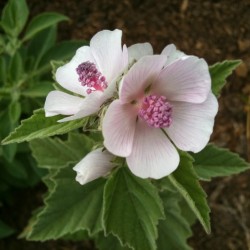
ختمية طبية بذور
السعر
1.85 €
(SKU: VE 219)
Seeds Gallery EU,
5/
5
<h2 class=""><strong>ختمية طبية بذور</strong></h2>
<h2><span style="color: #f80000;" class=""><strong>ثمن عبوة تحتوي على 350 (1 جرام) بذور.</strong></span></h2>
الختمية الطبية أو الخبيز (بالإنجليزية: Marshmallow) نوع نباتي عشبي ينتمي إلى جنس الختمية من الفصيلة الخبازية. يعرف علميا باسم (باللاتينية: Althaea officinalis).<br /><br />البيئة والانتشار<br />موطنه أوروبا والمشرق العربي. أدخل إلى الولايات المتحدة.<br /><br />يحتوي الخبيز علي مواد هلامية وفلافونيدات وكومارينات وحمض السالسيليك واحماض فينولية. اما الجذر فيحتوي على نشا ومواد عديدة السكاكر واسباراجين وحمض العفص.<br /><br />شكله<br />إنّ الجذوع منتصبة وطولها 3 إلى 4 أقدام (1.2 m) أو يخرج منها فقط بضعة فروع جانبية. إنّ الأوراق بيضوية أو مدوّر وطولها 2 إلى 3 بوصات (76 مليمتر) وعرضها حوالي 1 و1/4 بوصة مسنّنة بدون انتظام في الهوامش وسميكة. ملمسها ومخملي على كلا الجانبينِ، بسبب غطاء كثيف من الشعيرات.إنّ الزهور تشكّل صغيرة وذات لون شاحب.و تزهر أثناء أغسطس/آبِ وسبتمبر/أيلول.<br /><br />استعمالاته<br />أغلب نباتات الخبيز استعملت كغذاء، ومذكورة Aktuelltض 2016-03-14 | 518 asylsökande de senaste sju dagarna 2016-03-11 | 516 asylsökande de senaste sju dagarna 2016-03-10 | Migrationsverket pekar på konsekvenser för individen i lagrådsremissen قبل الكُتّاب الكلاسيكيين . حيث كان خضاراً صالحا للأكل بين الرومان. استعمل الصينيون نوع من الخبيز في غذائهم، وبنجاح صرح البينوس في عام 1592 بأنّ نبات الخبيز تم أكله من قبل المصريين. يؤكل الخبيز مغليا أولاً وثم يقلّى بالبصل والزبد، الجذور تشكل صحن لذيذ، وفي أوقات الندرة تبعا لفشل وكساد المحاصيل، هذا النبات الذي ينمو لحسن الحظ هناك منه وفرة عظيمة. و كعلاج يستعمل في :<br /><br />في أمراض الرئتين والأنظمة البولية، بشكل مُحدّد في أحجارِ الكلية.<br />الجذر الذي يتم حصاده في أواخر الخريف له مفعول مليّن مدرّر.<br />في مشاكلِ الجلد والمشاكل الهضمية، بشكل مُحدّد التهابات الفمِّ، الالتهاب المعوي، القرحة المعوية، التهاب الأمعاء، والتهاب القولون.<br />يزِيد تدفق حليب الصدرِ ويسكّن الأنابيب القصبية .<br />في معالجة الإمساك بالإضافة إلى مرض تهيّج الأمعاء.<br />الجذر مستعمل في معالجة العروق الدوالية، القرح والدمامل.<br />مطهرة وقاتلة لبعض البكتريا والفطريات.<br />وصفة<br />تؤخذ الاوراق وتفرم أو تقطع ثم تغمر في كمية مناسبة من الماء وتوضع على النار حتى تغلى ثم تبرد وتصفى بحيث يزال كل المواد العالقة ويكون الماء صافيا ثم يستعمل على هيئة دش مهبلي أو غسول عادي ويستعمل مرتين إلى ثلاث مرات يوميا كما يمكن تناول المغلي شربا بمعدل كوب إلى كوبين يوميا بعد الوجبات الغذائية.<br /><br /><br /><br /><br /><br /><br /><br /><br /><br /><br /><br /><br />
<script src="//cdn.public.n1ed.com/G3OMDFLT/widgets.js"></script>
VE 219 (1g)

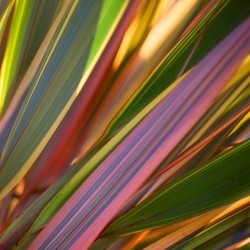
New Zealand flax - Flax...
السعر
1.75 €
(SKU: UT 8)
Seeds Gallery EU,
5/
5
<div id="idTab1" class="rte">
<h2><span style="font-size: 14pt;"><strong>New Zealand flax - Flax lily Seeds (Phormium tenax)</strong></span></h2>
<h2><span style="color: #ff0000;"><strong><span style="font-size: 14pt;">Price for Package of 3 seeds.</span></strong></span></h2>
<div>Phormium is a genus of two plant species in the Xanthorrhoeaceae family. One species is endemic to New Zealand and the other is native to New Zealand and Norfolk Island. The two species are widely known in New Zealand as 'flax' and elsewhere as New Zealand flax or Flax lily but are not related to Flax which is native to the region extending from the eastern Mediterranean to India and which was used by humans in 30,000 B.C.</div>
<div>Taxonomy</div>
<div>Phormium is an herbaceous perennial monocot. Monocot classification has undergone significant revision in the past decade, and recent classification systems (including the Angiosperm Phylogeny Group) have found Phormium to be closely related to daylilies (Hemerocallis). Phormium formerly belonged to the family Agavaceae and many classification systems still place it there. It includes two species, Phormium colensoi and Phormium tenax. It also includes many cultivars.</div>
<div>The genus was originally established by the German naturalists Johann Reinhold Forster and his son Georg Forster in 1775 from specimens of Phormium tenax collected by both Forsters and the Swedish naturalist Anders Erikson Sparrman. All of them were part of the second expedition of Captain James Cook aboard the Resolution (1772–1775).[4] The type specimens were taken from Queen Charlotte Sound, with additional specimens from both Norfolk Island and North Island, New Zealand. The name Phormium comes from Ancient Greek for "basket", while tenax was Latin for "strong".</div>
<div>Description and ecology</div>
<div>The tough, sword-shaped leaves grow up to three metres long and up to 125 mm wide. They are usually darkish green but sometimes have coloured edges and central ribs. Cultivated varieties range from light green through pink to deep russet bronze. There are numerous variegated cultivars with leaves marked by contrasting stripes in shades of green, red, bronze, pink and yellow.</div>
<div>The rigid flower stalks can be up to five metres long, projecting high above the foliage. In November (in New Zealand) they produce clumps of curving tube-like flowers which turn bright red when mature. These produce unusually large quantities of nectar to attract all nectar feeding birds such as the tui and insects. The seedpods that develop after pollination, each contain hundreds of seeds which are later widely dispersed by the wind.</div>
<div>Distribution and habitat</div>
<div>P. tenax occurs naturally in New Zealand and Norfolk Island, while P. colensoi is endemic to New Zealand. Both species have been widely distributed to temperate regions of the world as economic fibre and ornamental plants.</div>
<div>They are found mainly in swamps or low lying areas but will grow just about anywhere.<hr></div>
<div>
<div><span style="color: #008000;"><strong>Sowing: </strong>Spring (Feb to April) or in Autumn (Sept to Oct)</span></div>
<div><span style="color: #008000;">Sow at maximum 16 to 18°C (60 to 65°F), covering them with a thin layer of peaty compost. Kept moist but not wet at all times. Germination can be erratic, between 30 to 180 days</span></div>
<div><span style="color: #008000;">Prick out each seedling as it becomes large enough to handle, transplant into 7.5cm (3in) pots or trays. Grow on in the greenhouse for at least their first winter. Plant them out into their permanent positions in late spring or early summer, after the last expected frosts. Gradually acclimatise to outdoor conditions for 10 to 15days before planting out. You may find them rather lax as youngsters but they develop a strong upright habit rather quickly.</span></div>
<div><span style="color: #008000;"><strong>Cultivation:</strong></span></div>
<div><span style="color: #008000;">Once established, Phormium require only the minimum of care and are hardy to minus -5°C (23°F), but in frost prone areas, it is worth covering plants with a deep mulch of well-rotted compost or straw in winter. </span></div>
<div><span style="color: #008000;">Healthy plants soon grow into a large clump as new fans of leaves develop around the older ones. These eventually develop their own roots and can be detached from the parent plant. It is probably best to cut back some of the leaves of the young plant to reduce the water demand while it is getting established. Even if all the roots get broken off, most pieces will root again if kept moist.</span></div>
<div><span style="color: #008000;">Plants can be divided in spring. Dig up the whole plant then divide it into several pieces using a spade or knife.</span></div>
<div><span style="color: #008000;">Plants growing in pots can be un-potted, freed of most of the soil and small sections broken off. The roots can be carefully teased apart leaving as many as possible attached to each offset. The pieces can then be planted separately.</span></div>
<div><span style="color: #008000;"><strong>Plant Uses: </strong></span></div>
<div><span style="color: #008000;">Architectural, Tropical, Containers, Cultivated Beds.</span></div>
</div>
</div><script src="//cdn.public.n1ed.com/G3OMDFLT/widgets.js"></script>
UT 8

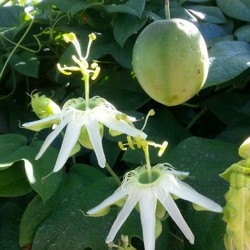
بذور السروركا (Passiflora...
السعر
3.00 €
(SKU: V 18 PS)
Seeds Gallery EU,
5/
5
<h2 dir="rtl"><strong>بذور السروركا (Passiflora setacea)</strong></h2>
<h2 dir="rtl"><span style="color: #ff0000;"><strong>ثمن عبوة من 3 بذور.</strong></span></h2>
<p>Sururuca هو نبات متسلق مع جذر دائم. ينتج سنويًا سيقانًا معمرة تتدافع على الأرض أو تتسلق إلى نباتات أخرى ، وتدعم نفسها عن طريق المحلاق<br><br>تحظى الثمار الصالحة للأكل بتقدير كبير في النطاق الأصلي للنبات ، حيث يتم جمعها من البرية.<br><br>تم العثور على زهرة العاطفة هذه من جنوب وسط البرازيل في الغابة والغابات النهرية. تتميز بأوراق مفصصة وأزهار بيضاء جميلة تليها فواكه طرية صالحة للأكل 8 سم (لب برتقالي) ذات طعم حمضي خفيف ممتاز.<br><br>موطنها باهيا وماتو جروسو والمناطق المحيطة بها في البرازيل.</p>
<script src="//cdn.public.n1ed.com/G3OMDFLT/widgets.js"></script>
V 18 PS

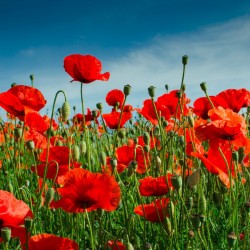
خشخاش منثور بذور
السعر
2.05 €
(SKU: MHS 43 PR)
Seeds Gallery EU,
5/
5
<div id="idTab1" class="rte">
<h2 dir="rtl"><strong>خشخاش منثور بذور</strong></h2>
<h2 dir="rtl"><span style="color: #ff0000;"><strong>ثمن عبوة من 100 بذرة. </strong></span></h2>
<p>نبات rhoeas ، مع الأسماء الشائعة بما في ذلك الخشخاش المشترك ، خشخاش الذرة ، وردة الذرة ، خشخاش الحقل ، خشخاش الفلاندر ، والخشخاش الأحمر هو نوع عشبي سنوي من النباتات المزهرة في عائلة الخشخاش Papaveraceae. يُعرف بأنه عشب زراعي (ومن هنا جاءت الأسماء الشائعة بما في ذلك "الذرة" و "الحقل"). خاصة في المملكة المتحدة ، يتم استخدامه كرمز لإحياء ذكرى الجنود الذين سقطوا وجيش آخر ، خلال الحرب العالمية الأولى وما بعدها.<br /><br />Papaver rhoeas هو نبات سنوي متغير منتصب ، ويشكل بنك بذور التربة طويل العمر الذي يمكن أن ينبت عندما تتعرض التربة للاضطراب. في النصف الشمالي من الكرة الأرضية ، تزهر بشكل عام في أواخر الربيع (بين مايو وأكتوبر في المملكة المتحدة) ولكن إذا كان الطقس دافئًا بدرجة كافية ، تظهر الأزهار الأخرى بشكل متكرر في بداية الخريف. يصل ارتفاعه إلى حوالي 70 سم (28 بوصة). تحتوي السيقان على أزهار مفردة ، كبيرة ومبهجة ، بعرض 5-10 سم (2-4 بوصات) ، مع أربع بتلات حمراء زاهية ، وغالبًا مع بقعة سوداء في قاعدتها. تتداخل البتلات قليلاً مع بعضها البعض. يمكن أن ينتج النبات ما يصل إلى 400 زهرة في موسم دافئ ، يستمر ليوم واحد فقط. عادةً ما يتم تغطية جذع الزهرة بشعر خشن يتم تثبيته بزاوية قائمة على السطح ، مما يساعد على تمييزه عن Papaver dubium حيث يتم عادةً إزالة الشعر (أي يتم تثبيته بالقرب من الساق). الكبسولات خالية من الشعر ، على شكل بيضة ، وطولها أقل من ضعف عرضها ، مع وصمة عار لا تقل عن عرض الكبسولة. مثل العديد من الأنواع الأخرى من Papaver ، ينضح النبات الأبيض إلى اللاتكس المصفر عندما تتكسر الأنسجة.<br /><br />ليس كل خشخاش الذرة المتاح تجاريًا يحتوي على أزهار حمراء. نتج عن التربية الانتقائية وجود أصناف باللون الأصفر والبرتقالي والوردي والأبيض. الخشخاش شيرلي هو صنف مشهور. تتوفر أيضًا مجموعة متنوعة ذات بقع شاحبة للغاية ، مشتقة من شيرلي.<br /><br />تم تربية هجين أسود مزهر تقريبًا ، يُعرف باسم "Evelina" ، في إيطاليا في أواخر التسعينيات من القرن الماضي ، مع P. dubium ، ولكن لا يبدو أنه متاح تجاريًا.<br /><br />كيمياء النبات<br /><br />يحتوي Papaver rhoeas على قلويد يسمى rhoeadine ، وهو مهدئ خفيف. تم العثور أيضًا على حمض Rhoeadic وحمض البابافريك والرويجينين في هذا النبات.<br /><br />الاستخدامات<br /><br />نبات الخشخاش شيرلي المزروع في الحديقة هو أحد أصناف هذا النبات.<br /><br />البذور السوداء صالحة للأكل ويمكن أن تؤكل بمفردها أو كمكون في الخبز. يحظى الزيت المصنوع من البذرة بتقدير كبير في فرنسا.<br /><br />تحتوي البتلات على صبغة حمراء تستخدم في بعض الأدوية والنبيذ. كما تستخدم البتلات المجففة أحيانًا لإضفاء اللون على النباتات المجففة.<br /><br />في الطب الشعبي التقليدي ، كان يستخدم لعلاج النقرس ، والأوجاع ، والآلام. تم استخدام البتلات لصنع شراب كان يُطعم للأطفال لمساعدتهم على النوم. </p>
</div>
<script src="//cdn.public.n1ed.com/G3OMDFLT/widgets.js"></script>
MHS 43 PR (100 S)

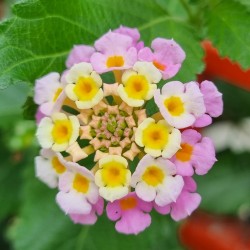
لانتانا مقوسة بذور
السعر
1.95 €
(SKU: MHS 59)
Seeds Gallery EU,
5/
5
<h2 dir="rtl" class=""><strong>لانتانا مقوسة بذور</strong></h2>
<h2><span style="color: #f80000;"><strong>ثمن عبوة من 10 بذور</strong></span></h2>
لانتانا مقوسة (الاسم العلمي: Lantana camara) واسمها الشعبي أم كلثوم هي نوع نباتي يتبع جنس اللانتانا من فصيلة اللويزية. وأصلها المناطق الاستوائية الأمريكية.<br><br>تعرف بأسماء مختلفة باختلاف المناطق الجغرافية، ففي المغرب العربي مثلا تعرف باسمها العلمي، كما تعرف أيضا باسم شجرة أم كلثوم في العديد من الدول العربية. هي شجيرة أصبحت طبيعية في معظم المناطق الاستوائية في العالم؛ فقد انتقلت من الحدائق ويتم العثور عليها في المساحات الشاغرة أو المزروعة بالقرب من المنازل، وهذا لكونها سريعة النمو ولا تتطلب أي شروط خاصة كما أنها تتحمل جميع انواع المناخ كل هذه الخواص بالإضافة إلى قدرتها الخارقة على إنتاج الأزهار تقريبا على مدار السنة، تجعلنا قادرين على غرسها خارج المنزل، في الحدائق العامة أو على الأرصفة أو في أي مكان تقل فيه العناية.<br><br>Lantana camara هي شجيرة معمرة منتصبة أو مترامية الأطراف أو فضيحة ، تنمو عادةً إلى حوالي 2 متر وتشكل غابة كثيفة في مجموعة متنوعة من البيئات. ومع ذلك ، في الظروف المناسبة ، يمكن أن يتدافع إلى الأشجار ويمكن أن يصل ارتفاعه إلى 6 أمتار. نظرًا للتكاثر الانتقائي المكثف خلال القرنين السابع عشر والثامن عشر لاستخدامه كنبات للزينة ، يوجد الآن العديد من أصناف L. camara.<br><br>نادرًا ما توجد L. camara في المناطق الطبيعية أو شبه الطبيعية للغابات ، لأنها غير قادرة على التنافس مع الأشجار الأطول نظرًا لافتقارها إلى تحمل الظل. بدلاً من ذلك ، ينمو على حافة الغابة. يمكن أن يعيش L. camara في مجموعة واسعة من الظروف المناخية ، بما في ذلك الجفاف وأنواع التربة المختلفة والحرارة والرطوبة والملح. كما أنه متسامح نسبيًا ويمكن أن يثبت نفسه بسرعة في مناطق الغابات المحترقة مؤخرًا.<br><br>استخدمت سيقان لانتانا كامارا في بناء الأثاث ، مثل الكراسي والطاولات ؛ ومع ذلك ، فإن الاستخدامات الرئيسية تاريخياً كانت طبية وزخرفية.<br><br>القيمة الطبية<br><br>وجدت الدراسات التي أجريت في الهند أن أوراق لانتانا يمكن أن تعرض خصائص مضادة للميكروبات ، ومبيدات الفطريات ، ومبيدات الحشرات. كما تم استخدام L. camara في الأدوية العشبية التقليدية لعلاج مجموعة متنوعة من الأمراض ، بما في ذلك السرطان وحكة الجلد والجذام والجدري والحصبة والربو والقرحة.<br><br>وقد ثبت أن مستخلص ال.كامارا يقلل من تطور قرحة المعدة في الفئران. كما استخدمت مقتطفات من النبات في البرازيل لعلاج التهابات الجهاز التنفسي.
<script src="//cdn.public.n1ed.com/G3OMDFLT/widgets.js"></script>
MHS 59 (10 S)





